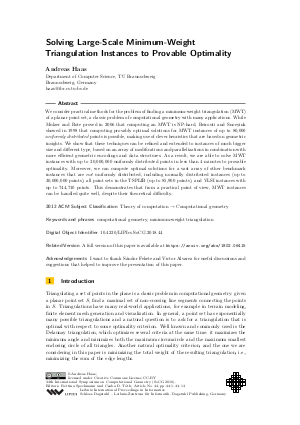Solving Large-Scale Minimum-Weight Triangulation Instances to Provable Optimality
Author Andreas Haas
-
Part of:
Volume:
34th International Symposium on Computational Geometry (SoCG 2018)
Part of: Series: Leibniz International Proceedings in Informatics (LIPIcs)
Part of: Conference: Symposium on Computational Geometry (SoCG) - License:
 Creative Commons Attribution 3.0 Unported license
Creative Commons Attribution 3.0 Unported license
- Publication Date: 2018-06-08
File

PDF
LIPIcs.SoCG.2018.44.pdf
- Filesize: 0.52 MB
- 14 pages
Document Identifiers
Subject Classification
Keywords
- computational geometry
- minimum-weight triangulation
Metrics
- Access Statistics
-
Total Accesses (updated on a weekly basis)
0Document
0Metadata
Abstract
We consider practical methods for the problem of finding a minimum-weight triangulation (MWT) of a planar point set, a classic problem of computational geometry with many applications. While Mulzer and Rote proved in 2006 that computing an MWT is NP-hard, Beirouti and Snoeyink showed in 1998 that computing provably optimal solutions for MWT instances of up to 80,000 uniformly distributed points is possible, making use of clever heuristics that are based on geometric insights. We show that these techniques can be refined and extended to instances of much bigger size and different type, based on an array of modifications and parallelizations in combination with more efficient geometric encodings and data structures. As a result, we are able to solve MWT instances with up to 30,000,000 uniformly distributed points in less than 4 minutes to provable optimality. Moreover, we can compute optimal solutions for a vast array of other benchmark instances that are not uniformly distributed, including normally distributed instances (up to 30,000,000 points), all point sets in the TSPLIB (up to 85,900 points), and VLSI instances with up to 744,710 points. This demonstrates that from a practical point of view, MWT instances can be handled quite well, despite their theoretical difficulty.
Cite As Get BibTex
Andreas Haas. Solving Large-Scale Minimum-Weight Triangulation Instances to Provable Optimality. In 34th International Symposium on Computational Geometry (SoCG 2018). Leibniz International Proceedings in Informatics (LIPIcs), Volume 99, pp. 44:1-44:14, Schloss Dagstuhl – Leibniz-Zentrum für Informatik (2018)
https://doi.org/10.4230/LIPIcs.SoCG.2018.44
BibTex
@InProceedings{haas:LIPIcs.SoCG.2018.44,
author = {Haas, Andreas},
title = {{Solving Large-Scale Minimum-Weight Triangulation Instances to Provable Optimality}},
booktitle = {34th International Symposium on Computational Geometry (SoCG 2018)},
pages = {44:1--44:14},
series = {Leibniz International Proceedings in Informatics (LIPIcs)},
ISBN = {978-3-95977-066-8},
ISSN = {1868-8969},
year = {2018},
volume = {99},
editor = {Speckmann, Bettina and T\'{o}th, Csaba D.},
publisher = {Schloss Dagstuhl -- Leibniz-Zentrum f{\"u}r Informatik},
address = {Dagstuhl, Germany},
URL = {https://drops.dagstuhl.de/entities/document/10.4230/LIPIcs.SoCG.2018.44},
URN = {urn:nbn:de:0030-drops-87576},
doi = {10.4230/LIPIcs.SoCG.2018.44},
annote = {Keywords: computational geometry, minimum-weight triangulation}
}
Author Details
References
-
Oswin Aichholzer, Franz Aurenhammer, and Reinhard Hainz. New Results on MWT Subgraphs. Inf. Process. Lett., 69(5):215-219, 1999.

-
Ronald Beirouti. A Fast Heuristic for Finding the Minimum Weight Triangulation. Master’s thesis, University of British Columbia, Vancouver, BC, Canada, Canada, 1997.

-
Ronald Beirouti and Jack Snoeyink. Implementations of the LMT Heuristic for Minimum Weight Triangulation. In Ravi Janardan, editor, Symposium on Computational Geometry, pages 96-105. ACM, 1998.

-
Patrice Belleville, J. Mark Keil, Michael McAllister, and Jack Snoeyink. On Computing Edges That Are In All Minimum-Weight Triangulations. In Sue Whitesides, editor, Symposium on Computational Geometry, pages 507-508. ACM, 1996.

-
Cgal, Computational Geometry Algorithms Library. http://www.cgal.org.

-
Gautam Das and Deborah Joseph. Which triangulations approximate the complete graph?, pages 168-192. Springer Berlin Heidelberg, Berlin, Heidelberg, 1989.

-
Matthew Dickerson, J. Mark Keil, and Mark H. Montague. A Large Subgraph of the Minimum Weight Triangulation. Discrete &Computational Geometry, 18(3):289-304, 1997.

-
Matthew Dickerson and Mark H. Montague. A (Usually?) Connected Subgraph of the Minimum Weight Triangulation. In Sue Whitesides, editor, Symposium on Computational Geometry, pages 204-213. ACM, 1996.

-
Robert L. Scot Drysdale, Scott A. McElfresh, and Jack Snoeyink. On exclusion regions for optimal triangulations. Discrete Applied Mathematics, 109(1-2):49-65, 2001.

-
Michael R. Garey and David S. Johnson. Computers and Intractability: A Guide to the Theory of NP-Completeness. W. H. Freeman &Co., New York, NY, USA, 1979.

-
P. D. Gilbert. New results in planar triangulations. Master’s thesis, University Illinois, 1979.

-
Magdalene Grantson, Christian Borgelt, and Christos Levcopoulos. A Fixed Parameter Algorithm for Minimum Weight Triangulation: Analysis and Experiments. Technical report, Lund University, Sweden, 2005.

-
Magdalene Grantson, Christian Borgelt, and Christos Levcopoulos. Minimum Weight Triangulation by Cutting Out Triangles. In Xiaotie Deng and Ding-Zhu Du, editors, ISAAC, volume 3827 of Lecture Notes in Computer Science, pages 984-994. Springer, 2005.

-
Magdalene Grantson, Christian Borgelt, and Christos Levcopoulos. Fixed Parameter Algorithms for the Minimum Weight Triangulation Problem. Int. J. Comput. Geometry Appl., 18(3):185-220, 2008.

-
Gisli R. Hjaltason and Hanan Samet. Ranking in Spatial Databases. In SSD '95: Proceedings of the 4th International Symposium on Advances in Spatial Databases, pages 83-95, London, UK, 1995. Springer-Verlag.

-
Michael Hoffmann and Yoshio Okamoto. The Minimum Weight Triangulation Problem with Few Inner Points. In Rodney G. Downey, Michael R. Fellows, and Frank K. H. A. Dehne, editors, IWPEC, volume 3162 of Lecture Notes in Computer Science, pages 200-212. Springer, 2004.

-
G.T. Klincsek. Minimal Triangulations of Polygonal Domains. Annals of Discrete Mathematics, 9:121-123, 1980.

-
Bernard M. E. Moret and Henry D. Shapiro. Algorithms from P to NP (Vol. 1): Design and Efficiency. Benjamin-Cummings Publishing Co., Inc., Redwood City, CA, USA, 1991.

-
Wolfgang Mulzer and Günter Rote. Minimum-weight Triangulation is NP-hard. J. ACM, 55(2):11:1-11:29, 2008.

-
G. Reinelt. TSPLIB- a Traveling Salesman Problem Library. ORSA Journal of Computing, 3(4):376-384, 1991.

